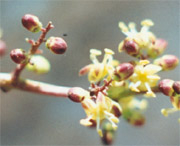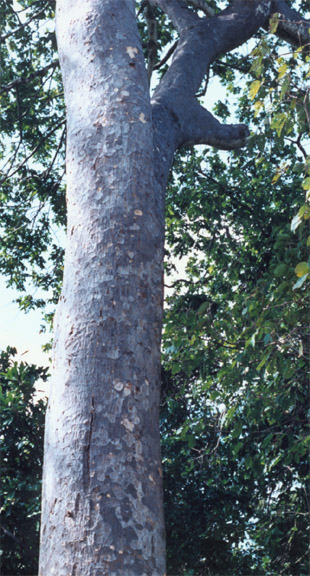Astronium graveolens Jacq.
Anacardiaceae Common Name: RON RON
Occasional to common evergreen canopy tree (25-35m) best known for its high-quality, rich-veined wood. Ron-ron is most likely to be found in the dry tropical forest, where its omnipresent green crown and light-gray, pockmarked trunk often make it easy to identify.
Description: Ron-ron has a moderately irregular, mostly straight trunk (60cm). The highly characteristic bark is gray and smooth, though the bole itself is mottled and contoured by tan pockmarks that are formed as older bark is shed in roundish pieces. Branching in this species is not profuse, and the crown is only moderately thick. As in other members of the Anacardiaceae, broken twigs and foliage exude a clear, resinous, acrid-smelling sap. Ron-ron leaves (25cm by 12cm) are imparipinnately compound and alternately arranged. Each consists of about 7 to 11 lance-shaped leaflets with slightly serrate edges. Leaves are shed annually in the early dry season (Jan.-Feb) and they often take on an eye-catching bright red hue at this time. New foliage is generated immediately thereafter.
This tree’s inconspicuous flowers (0.4cm) are small and light yellow to lavender in color. With five petals and five short stamens, they occur in branched panicles during March. Fruits (1.5cm) grow quickly thereafter, reaching maturity by late April. Each is a golden-brown, star-shaped, papery structure, with a single narrow, thin, wrinkled seed at its center. Though they appear lifeless, these seeds germinate rapidly with the first rains of April or May.
Natural History: Ron-ron flowers are pollinated by small insects, while its seeds are wind-dispersed. Through much of its habitat, strong trade winds are still blowing in the late dry season when the light fruits are released from high branches. Ron-ron is a dry-adapted species, thriving in locations with a prolonged (up to six months) dry season.
Uses: Ron-ron wood is highly prized for its density, strength, and dark, thin veins. It is used in artisinry, furniture-making, and house construction. Allen (1956) says that it is resistant to moisture, and that it weathers well, and he includes it among Costa Rica’s most important timber trees.
Range: Ron-ron is found along Costa Rica’s Pacific slope from dry Guanacaste (where it is most common), south to Punta Leona and finally the Osa Peninsula where it is rare (Jimenez, 1998). It is particularly abundant in Santa Rosa and Palo Verde National Parks. The tree ranges from Mexico to Paraguay (Jimenez, 1998).
Photos: Tree Tree2 Tree3 Tree4 Trunk Trunk2 Trunk3 Leaf Flower Flower 2 Fruit Seedling




